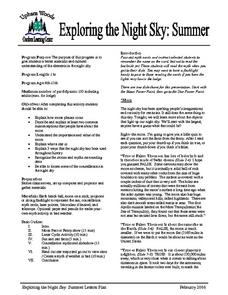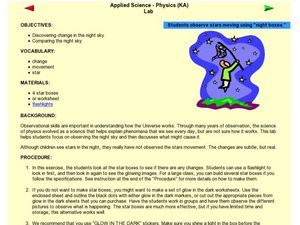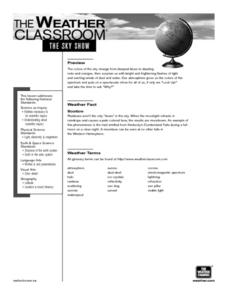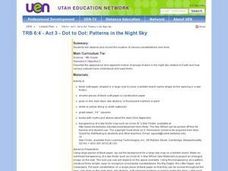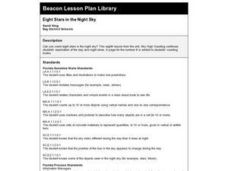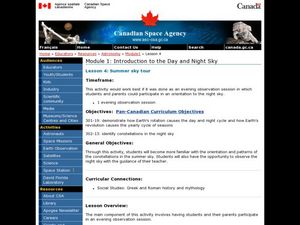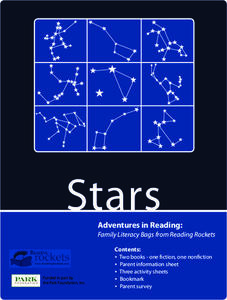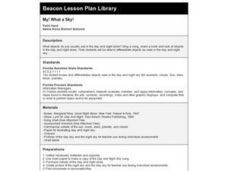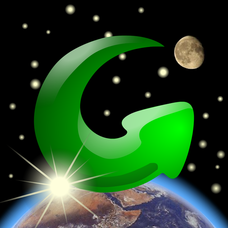Curated OER
Exploring the Night Sky: Summer
Students explain how moon phases occur. They describe and explain at least two common misconceptions that people have about the moon. Students explain what a star is. They explain 3 ways that the night sky has been used throughout history.
Curated OER
Night Sky Observation
Students explore space science by completing an observational worksheet. In this astronomy lesson, students view several worksheets in which students identify minor changes between separate images in preparation for real star...
Magic of Physics
Rotating Sky
Ever found it difficult to observe the night sky with pupils because school takes place during the day? Host a stellar lesson using a detailed night sky interactive! Scholars view the apparent rotation of the sky from the comfort of the...
Curated OER
Sky Watching
Students complete night-sky observations to understand how our knowledge of the sky has been enhanced by telescopes. Students complete a timeline worksheet giving the history of telescopes. Students then then make their own observations...
Curated OER
An Introduction to the Night Sky and Movement Astronomy
Basically, this is an interactive exploration of educational astronomy software and an app. Young astronomers discover how the apparent motion of the sky relates to Earth's movements and the position of the observer. It is out of this...
Star Date
Modeling the Night Sky
Dramatize the stars and planets as they become a visual representation of the solar system in this activity. Young astronomers track and simulate various constellations as they orbit the Earth to learn the position and motion of...
Curated OER
Introduction to the Day and Night Sky
Students explore space science by participating in a sky observation activity. In this astronomy activity, students define a list of astronomy vocabulary terms and examine star charts of the four seasons. Students gather with their...
Curated OER
Day and Night
Inform your elementary scientists why we experience day and night. They are provided with facts and explanation as to why the day and night cycle occur, discuss what they've learned with a partner, and are then given the task of writing...
Curated OER
Sky Show
Students participate in a discussion of the sky and colors. They watch a demonstration of how colors can change. They examine the issue of if weather should be a part of their coursework.
Curated OER
Dot to Dot: Patterns in the Night Sky
Sixth graders are introduced to several major constellations and locate them in the night sky. They graph the constellations on grid paper and work in groups to research common myths and stories associated with specific constellations.
Curated OER
Eight Stars in the Night Sky
First graders explore the day and night sky. They complete a number 8 page for their counting books.
Curated OER
Too Bright at Night?
Young scholars reflect upon the causes and effects of light pollution in the night skies. First, they read articles provided and then do worksheets that are provided. They work in groups to discuss their conclusions.
Curated OER
Summer Sky Tour
Young scholars explore space science by participating in a constellation identification activity. In this astronomy lesson, students view star charts based on the different seasons and define a list of astronomy related terms. Young...
PBS
Reading Adventure Pack: Stars
A Reading Adventure Pack explores the night sky. Reading Her Seven Brothers by Paul Goble and Find the Constellations by H.A. Rey begin the learning experience. Scholars craft a night sky mobile, go stargazing, and write a mythical story...
Curated OER
The Night Sky
Third graders develop questions they have about the solar system. After being read a book, they view and discuss different constellations in the sky. In groups, they are given a piece of butcher paper and glow in the dark crayons in...
Curated OER
Sky Observation Project
In this sky observation learning exercise, middle schoolers make observations of the night sky and use their planisphere and star charts to help identify what they observe. They make observations and record what they see for 10-15...
Colorado State University
Why Does it Get Colder on a Clear Night than a Cloudy Night?
Clouds are nature's insulator! A lab investigation asks learners to use an infrared thermometer to measure differences in infrared temperatures. They find that pointing the thermometer at a cloud has a much different result than pointing...
California Academy of Science
Paper Cup Planetarium
Bring the night sky to your classroom! Using simple materials, learners create flashlight constellations on the wall. They then use their imaginations to create their own star patterns that tell a story.
Curated OER
Banner of Stars
Young scholars create a motivational star banner to inspire the writing of poetry. As a class they read poems, songs, and quotes about stars and night skies, view and discuss "Starry Night" by Vincent Van Gogh, then create a star banner...
Curated OER
My! What a Sky!
First graders read "Goodnight Moon" or "Day And Night" and discuss what they see in day and night skies. They read and sing lyrics to the "Day and Night" song. They identify objects in the sky as day or night objects. They illustrate day...
Curated OER
Starry, Starry Night
Students, using construction paper, and an empty black film canster with no lid, create their own night sky full of stars that can be seen in the middle of the day.
Curated OER
Exploring the Night Sky: Fall/Winter
Students explain how moon phases occur. They explain three ways that the night sky has been used through history. Students locate some of the constellations in the night sky. They discuss stories and myths surrounding stars.
Curated OER
Night Sky
Pupils discover why stars can only be seen at night. They participate in a read aloud of, "Night Sky" by Carole Stott and, "Switch on the Night" by Ray Bradbury. Using the sky objects described in the readings, they brainstorm and list...
GoSoftWorks
GoSkyWatch Planetarium for iPad - The Astronomy Star Guide
Digital compass alignment enables navigation of the skies with true orientation at any time. Just point to the sky or "aim for the stars!" This application acts as a virtual telescope, allowing you to zoom in on any object that is...
Other popular searches
- Day and Night Sky
- The Night Sky
- Night Sky Myths
- Observing the Night Sky
- Night Sky 2nd Grade
- Observe the Night Sky
- Night Sky Counting Book
- Day Night Sky
- Day Sky Night Sky
- Night Sky Viewing
- Solar System Night Sky
- Stars, Night Sky
